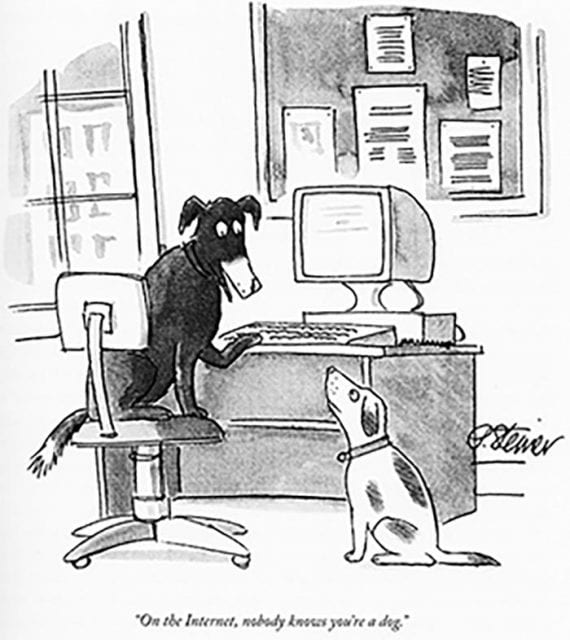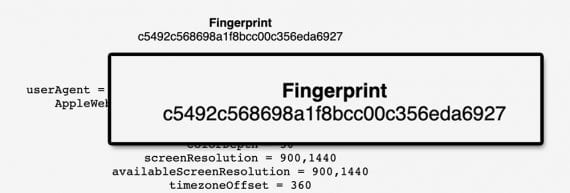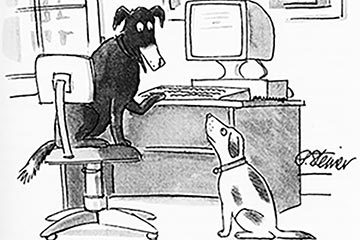As Cookies Crumble, Fingerprinting Could Grow
[ad_1]
Privateness advocates, tech corporations, and authorities regulators are all working to carry an finish to third-party cookies. However even because the cookies crumble, some advert networks may flip to browser fingerprinting to trace people.
“In July 1993, The New Yorker revealed a cartoon by Peter Steiner that depicted a Labrador retriever sitting on a chair in entrance of a pc, paw on the keyboard, as he turns to his beagle companion and says, ‘On the Web, no person is aware of you’re a canine.’ 20 years later, events not solely know you’re a canine, however additionally they have a reasonably good concept of the colour of your fur, how usually you go to the vet, and what your favourite doggy deal with is,” wrote Nick Nikiforakis and Günes Acar in a July 2014 article for the Institute of Electrical and Electronics Engineers (IEEE) Spectrum journal.

In 1993, cartoonist Peter Steiner noticed the web as a spot of anonymity, however that has clearly modified. Supply: Wikipedia.
Browser Fingerprinting
Cookies are one of many easiest ways for promoting networks to trace people. When a writer places advertisements on its web site, the advert community locations a cookie on every new customer’s machine. When that very same customer goes to a different web site utilizing the identical advert community, the cookie is acknowledged, and the person is tracked. The cookie is positioned by a 3rd celebration (the advert community) and never the writer. Thus, it’s a third-party cookie, additionally known as a monitoring cookie.
Fb and Google, that are among the many largest advert networks, do that at scale.
As frequent as they’re, monitoring cookies are not the only way advert networks observe people. For a few years, plenty of advert networks have additionally used browser fingerprinting.
Because the identify implies, browser fingerprinting is comparable in idea to precise fingerprinting. When the police fingerprint a suspect, they evaluate that fingerprint to a database of beforehand collected prints. When two prints match, they’re assumed to be the identical particular person.
Once you go to a web site, your browser shares details about itself and your machine. This info consists of issues like:
- The browser you’re utilizing (e.g., Chrome, Safari, Firefox),
- The language (e.g., English, Spanish) your system is about to,
- Coloration depth,
- Display screen decision
- Time zone,
- Platform (e.g., Home windows, Mac),
- WebGL settings,
- Storage settings,
- Plugins.
When a number of of those factors of data match, an promoting community is aware of with a reasonably excessive diploma of certainty that it has the identical particular person in view.
Fingerprinting Is Straightforward
Rob Braxman, a web based privateness advocate, has a browser fingerprinting tool that may produce a hash or worth representing you. On Braxman’s software, this worth is labeled “Fingerprint.” Should you go to the software in Chrome, for instance, then shut the browser and reopen it, you’ll discover an an identical fingerprint. The software is aware of who you might be with out the help of a cookie.

Privateness knowledgeable Rob Braxman was capable of determine a browser and, by affiliation, its person through a fingerprint.
Matching a number of parameters about your browser and your machine may not seem to be an correct method to monitor, however it’s.
The Digital Frontier Basis, which promotes privateness on-line, has its personal browser fingerprinting test known as “Cowl Your Tracks.” A latest take a look at on Cowl Your Monitor exhibits that about 18 items of data from a browser made it potential to determine me from a pool of 246,417 assessments carried out for a 45-day interval.

Cowl Your Tracks recognized 18 items of information that recognized the writer out of 245,417 prospects.
Fingerprinting Is Widespread
Browser fingerprinting just isn’t new and never obscure.
“Fingerprinting the Fingerprinters: Learning to Detect Browser Fingerprinting Behaviors,” a paper ready for the IEEE’s 2021 Symposium on Safety & Privateness, described how researchers Umar Iqbal from the College of Iowa, Steven Englehardt from the Mozilla Company, and Zubair Shafiq from the College of California, Davis have been capable of detect browser fingerprinting.
These researchers analyzed the 100,000 hottest web sites based mostly on Alexa rankings. Of those, their fingerprint tracker discovered that greater than 10,000 or roughly 10 % (25 % of the highest 10,000) have been fingerprinting guests.
These websites have causes to make use of browser fingerprints. As talked about, fingerprinting could be efficient at monitoring. It might additionally detect advert fraud and foil privateness safety or anti-tracking software program.
It isn’t unreasonable to assume that promoting networks may improve the usage of browser fingerprinting as monitoring cookies change into much less accessible.
Commerce Advertisers
Educating advertisers is a facet impact of the private privateness motion.
Many digital entrepreneurs at commerce corporations — ecommerce outlets, omnichannel retailers, B2B suppliers — didn’t absolutely perceive how browser fingerprinting labored.
Now that they understand how invasive and secretive browser fingerprinting is, these advertisers can decide if they’re comfy shopping for advertisements on networks that make use of it.
[ad_2]
Source link

